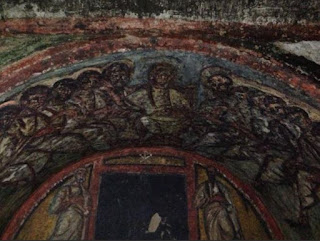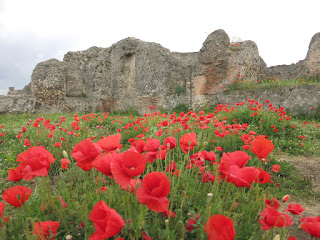ROMAN CATACOMBS
The Catacombs of Rome are ancient underground burial places under or near Rome, Italy, some discovered only in recent decades. Though most famous for Christian burials, either in separate catacombs or mixed together, they began in the 2nd century, much as a response to overcrowding and shortage of land. Many scholars have written that catacombs came about to help persecuted Christians to bury their dead secretly. The soft volcanic tuff rock under Rome is highly suitable for tunneling, as it is softer when first exposed to air, hardening afterwards. Many have miles of tunnels, in up to four stories (or layers).
The Christian catacombs are extremely important for the history of early Christian art, as they contain the great majority of examples from before about 400 AD, in fresco and sculpture. The Jewish catacombs are similarly important for the study of Jewish art of this period.
The Christian catacombs are extremely important for the history of early Christian art, as they contain the great majority of examples from before about 400 AD, in fresco and sculpture. The Jewish catacombs are similarly important for the study of Jewish art of this period.
The Etruscans, like many other European peoples, used to bury their dead in underground chambers. The original Roman custom was cremation, after which the burnt remains were kept in a pot, ash-chest or urn, often in a columbarium. From about the 2nd century AD, inhumation (burial of unburnt remains) became more fashionable, in graves or sarcophagi, often elaborately carved, for those who could afford them. Christians also preferred burial to cremation because of their belief in bodily resurrection at the Second Coming.
Catacombs (contrary to poularized belief) probably were not used for regular worship. Many depictions of the catacombs show them as hiding places for Christian populations during times of persecution. There are sixty known subterranean burial chambers in Rome.
Bodies were placed in chambers in stone sarcophagi in their clothes and bound in linen. Then the chamber was sealed with a slab bearing the name, age and the day of death. Fresco decorations were typically Roman.
In 380 AD, Christianity became a state religion. At first many still desired to be buried in chambers alongside martyrs. However, the practice of catacomb burial declined slowly, and the dead were increasingly buried in church cemeteries. In the 6th century catacombs were used only for martyrs' memorial services, though some paintings were added as late as the 7th century. Ostrogoths, Vandals and Lombards that sacked Rome violated the catacombs, presumably looking for valuables. By the 10th century catacombs were practically abandoned, and holy relics were transferred to above-ground basilicas.
In the intervening centuries catacombs remained forgotten until they were accidentally rediscovered in 1578, and in 1956 and 1959 Italian authorities found more catacombs near Rome. Currently, maintenance of the catacombs is in the hands of the papacy
CATACOMBS OF DOMITILLA
Right next door to our Rome hotel are the large and impressive Catacombs of Domitilla (named after Saint Domitilla), spread over 11 miles of underground caves.
The Domitilla Catacombs are unique in that they are the oldest of Rome's underground burial networks, and the only ones to still contain bones. They are also the best preserved and one of the most extensive of all the catacombs. Included in their passages are a 2nd century fresco of the Last Supper and other valuable artifacts.
In the beginning of 2009, at the request of the Vatican, the Divine Word Missionaries, a Roman Catholic Society of priests and Brothers, assumed responsibility as administrator of St. Domitilla Catacombs.
Goodbye To Rome
We checked out of the Hotel, and now our driving tour began. It didn't take long before we were cut off, and honked at. Fortunately, we were driving away from the city, onto the Autostrada, and did not encounter much traffic.We had our GPS hooked up (we named her Sophia), and my job was to find a decent radio station. I found a station that played soft rock, some of it in Italian, some popular American songs, and one very strange acoustic version of Nirvana's " Come as You Are".
It was a pleasant drive, through rolling hills, and we passed vineyards and olive groves. The service areas were surprisingly nice, with restaurants and markets where you could purchase Italian jams, wines and interesting pastas.
I was a little concerned when we left the Autostrada to go into Pompeii . . . the roads were winding and narrow, and I thought that the town was ugly. We had a little trouble finding our AirBnB apartment, but it turned out to be a lovely apartment in a nice neighborhood, within walking distance of the ruins ! Our host had left coffee, tea and cookies out for us, which we certainly took advantage of before walking to the excavated ruins of Pompeii.
Pompeii
Pompeii has been a tourist destination for over 250 years. Today it has UNESCO World Heritage Site status and is one of the most popular tourist attractions in Italy, with approximately 2.5 million visitors every year.
Pompeii was an ancient Roman town-city near modern Naples, in the Campania region of Italy. Pompeii, along with Herculaneum and many villas in the surrounding area, was mostly destroyed and buried under 13 to 20 feet of volcanic ash and pumice in the eruption of Mount Vesuvius in AD 79.
 Researchers believe that the town was founded in the seventh or sixth century BC and came under the domination of Rome in the 4th century BC. The city was conquered and became a Roman colony in 80 BC after it joined an unsuccessful rebellion against the Roman Republic. By the time of its destruction, 160 years later, its population was estimated at 11,000 people, and the city had a complex water system, an amphitheater, gymnasium, and a port.
Researchers believe that the town was founded in the seventh or sixth century BC and came under the domination of Rome in the 4th century BC. The city was conquered and became a Roman colony in 80 BC after it joined an unsuccessful rebellion against the Roman Republic. By the time of its destruction, 160 years later, its population was estimated at 11,000 people, and the city had a complex water system, an amphitheater, gymnasium, and a port.The eruption destroyed the city, killing its inhabitants and burying it under tons of ash. Evidence for the destruction originally came from a surviving letter by Pliny the Younger, who saw the eruption from a distance and described the death of his uncle Pliny the Elder, an admiral of the Roman fleet, who tried to rescue citizens. The site was lost for about 1,500 years until its initial rediscovery in 1599 and broader rediscovery almost 150 years later by Spanish engineer Rocque Joaquin de Alcubierre in 1748. The objects that lay beneath the city have been preserved for centuries because of the lack of air and moisture. These artifacts provide an extraordinarily detailed insight into the life of a city during the Pax Romana. During the excavation, plaster was used to fill in the voids in the ash layers that once held human and animal bodies. This allowed one to see the exact position the person was in when he or she died.
The above is a web link to a short video re-enacting the Vesuvius eruption and the destruction of Pompeii - Tom and I thought it provides a good depiction of the utter devastation affecting all those inhabitants !
Winding Down
Located in the town is the magnificent Shrine of the Virgin of the Rosary of Pompeii. Built in the 1870's, it can accommodate 6000 people. In 1901 the sanctuary became a papal Basilica by order of Pope Leon XIII.
 The painting of the “Vergine del Rosario con il Bambino” with its bronze gilt frame is exposed on the high altar. Today the painting is object of deep veneration and the story of its acquisition is really strange.
The painting of the “Vergine del Rosario con il Bambino” with its bronze gilt frame is exposed on the high altar. Today the painting is object of deep veneration and the story of its acquisition is really strange.The painting was bought from a second-hand dealer by Father Alberto Maria Radente belonging to the convent of “S. Domenico Maggiore” who gave it as a gift to Bartolo Longo.
Then the painting was brought to Pompeii by a farmer on a barrow full of manure.
At this point a young girl went to the sanctuary where she prayed to the Madonna to be cured from epilepsy; and from that moment the church became a place of pilgrimage because she was cured immediately !
On our walk back to the apartment, we discovered a large Supermarket, where we found the Spanish paella that we had loved on our trip to Spain 2 years ago. Along with a bottle of local Italian wine (less than 3 euros), it was the perfect end to our Bucket List day.











No comments:
Post a Comment